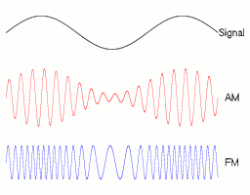Amplitude modulation
Amplitude Modulation, usually shortened to AM, is a simple way to send a radio signal. The signal can travel long distances, and appear in faraway places, because of the earth's ionosphere.
Amplitude is the height of a wave. A carrier wave is modulated (changed) by adding audio. The combined signal is transmitted over a frequency. AM signals can be received by a crystal-powered radio set, that needs no batteries or electrical power source. Many early radios were homemade, and used earphones.
AM signals are mostly sent out on medium wave and shortwave frequencies. They do not carry high fidelity sound, but the sound is good enough to hear most things. Analog signals can fade in and out, or have interference from power lines and power stations. Sunspot activity can also weaken signals.
In the early years of commercial broadcasting in the 1920s, medium wave AM (from 540 to 1600 kilocycles) was the only kind of radio widely used. Radio programs were much like today's television programs, including news, sports, drama, music, comedy, and other entertainment.
Later Frequency Modulation (FM) radio was developed. It had better fidelity, but the signals could not travel as far, so AM was still important. After television became common in the 1950s, AM became a major format for popular music. As FM became common in the 1970s, AM stations featured more news, and talk shows.
Shortwave radio signals (from 3000 to 30,000 kilocycles) can travel around the world, and are used by countries to send programs to distant places. These programs feature news about the country, examples of their native culture and history, and sometimes foreign language lessons.
Amplitude Modulation Media
An audio signal (top) carried by a carrier signal using amplitude modulation (middle) and frequency modulation (bottom).
One of the crude pre-vacuum tube AM transmitters, a Telefunken arc transmitter from 1906. The carrier wave is generated by 6 electric arcs in the vertical tubes, connected to a tuned circuit. Modulation is done by the large carbon microphone (cone shape) in the antenna lead.
One of the first vacuum tube AM radio transmitters, built by Meissner in 1913 with an early triode tube by Robert von Lieben. He used it in a historic 36 km (22 mi) voice transmission from Berlin to Nauen, Germany. Compare its small size with the arc transmitter above.
Figure 3: The spectrogram of an AM voice broadcast shows the two sidebands (green) on either side of the carrier (red) with time proceeding in the vertical direction.








